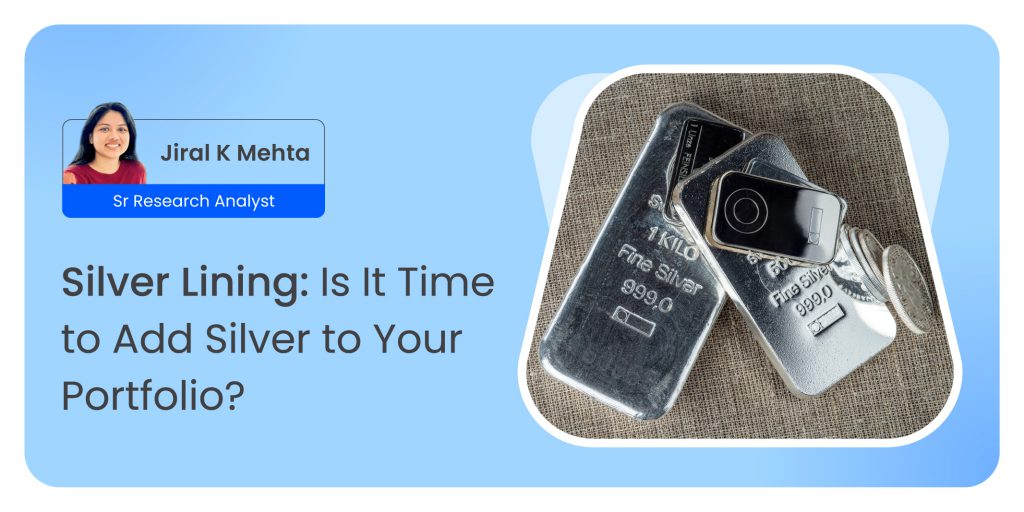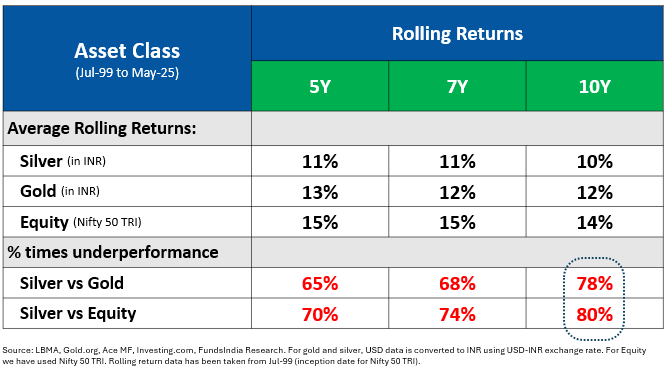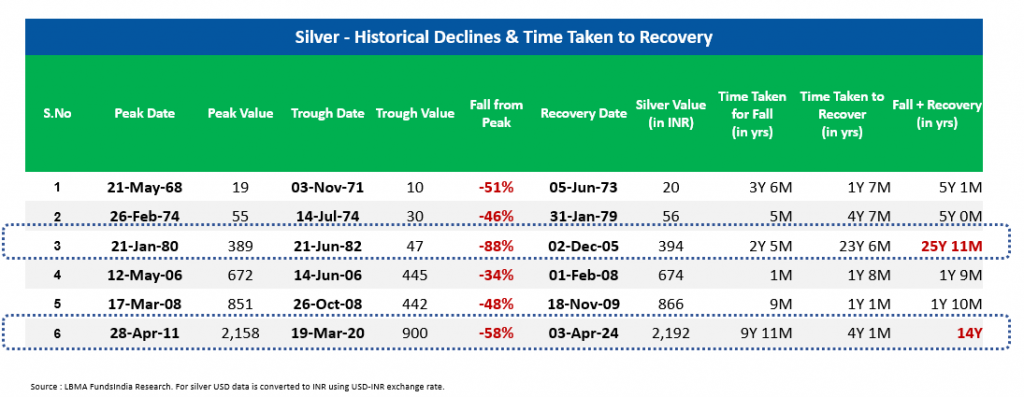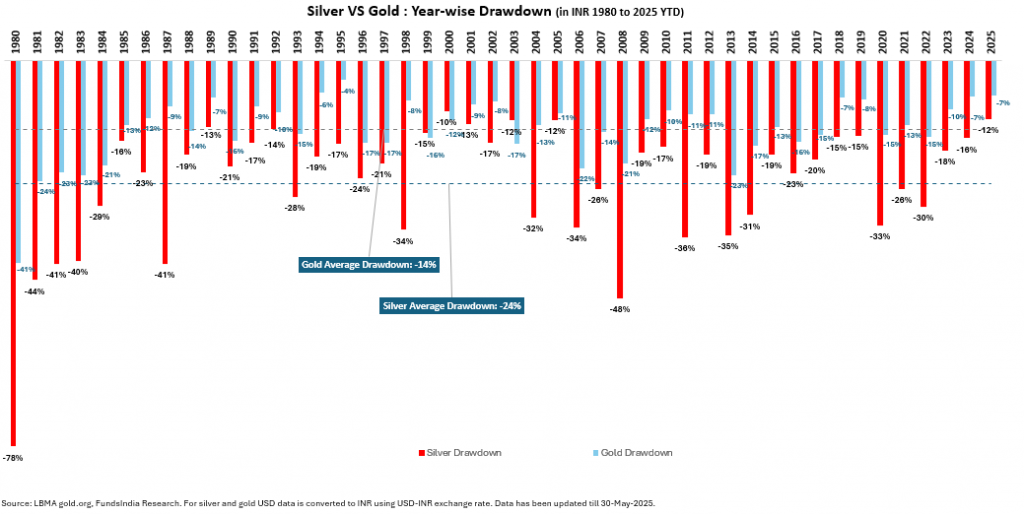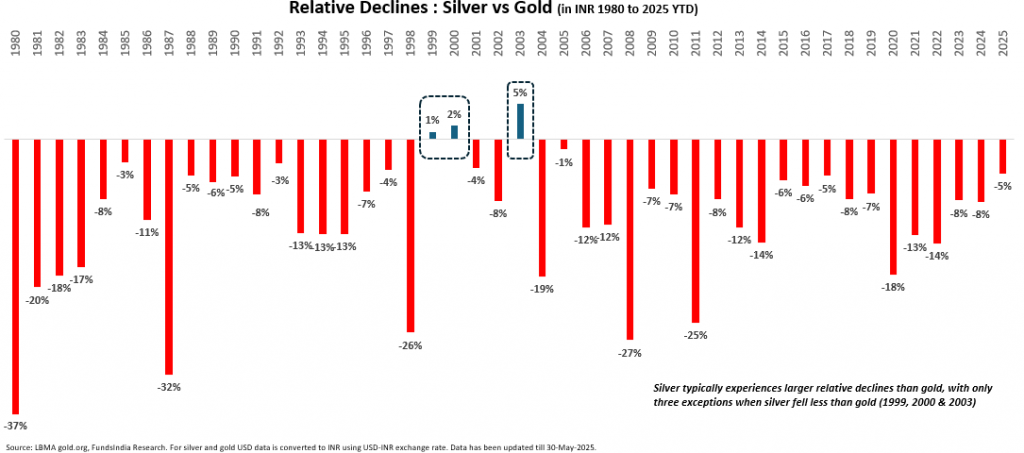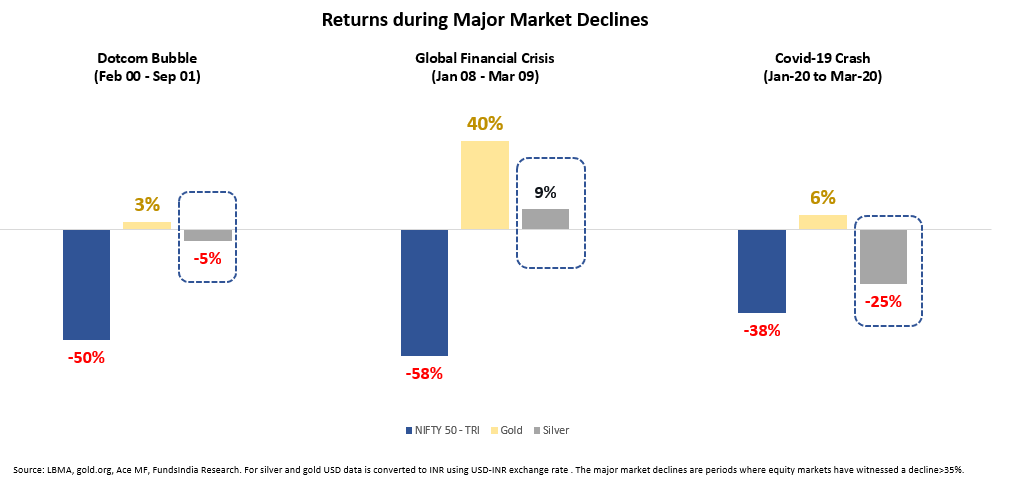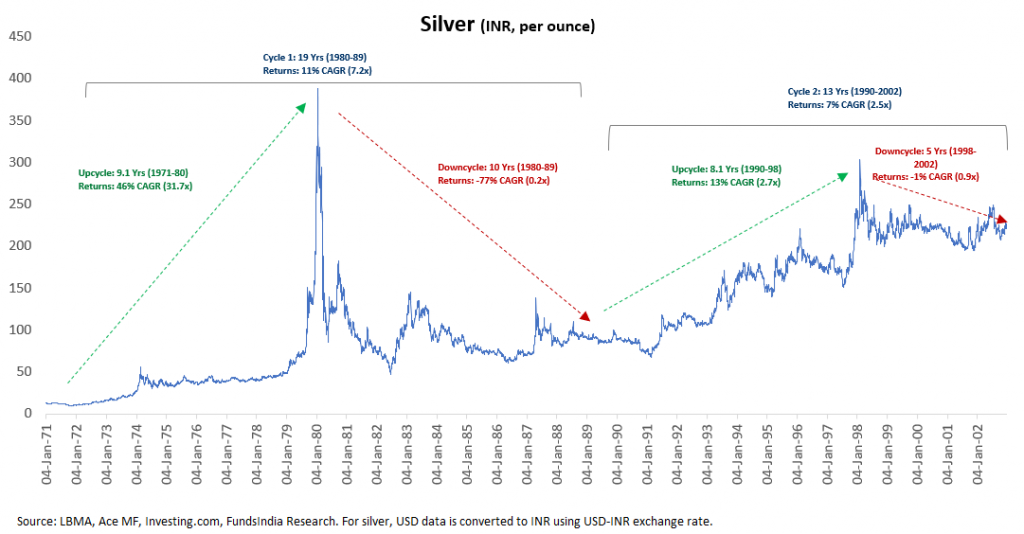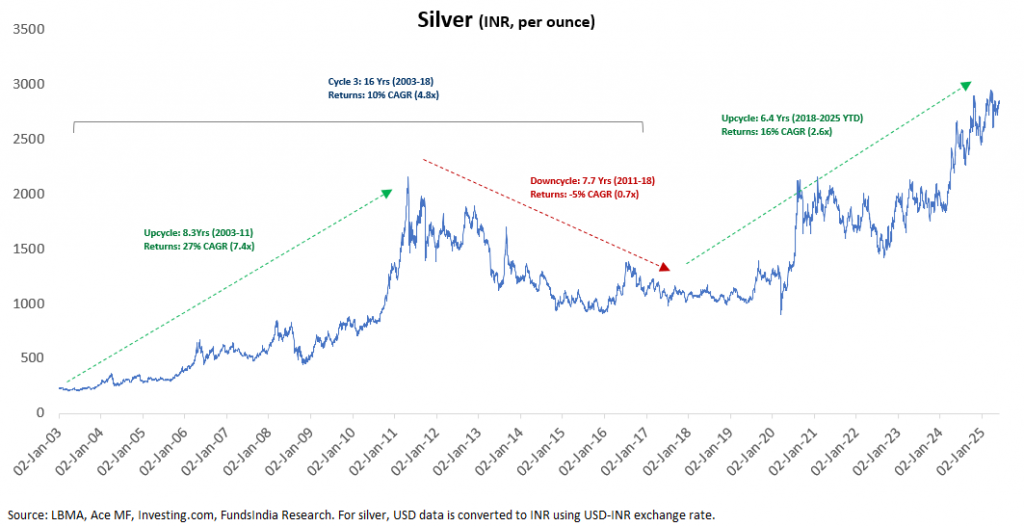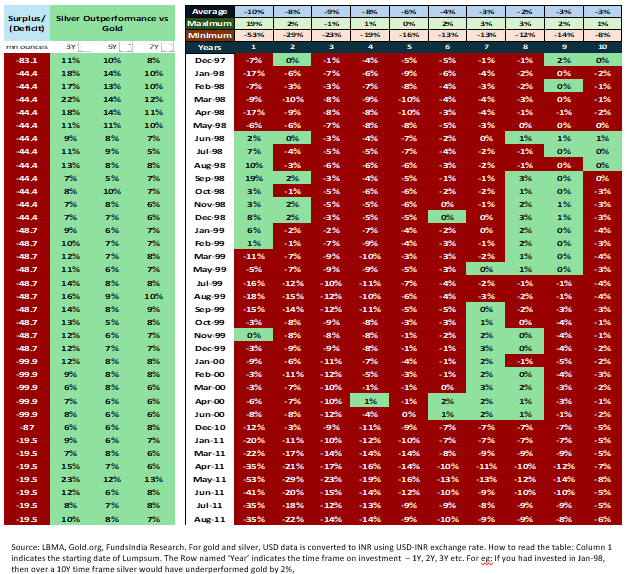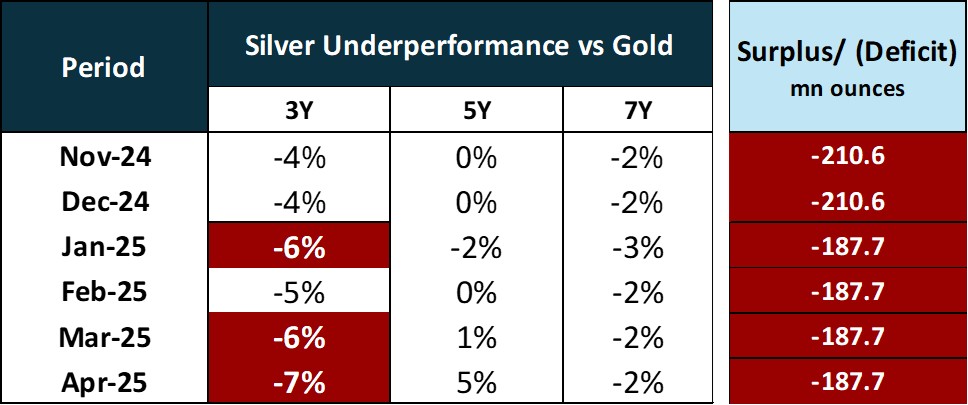Silver has lengthy been considered a retailer of worth, second solely to gold within the treasured metals hierarchy. However lately, silver has moved past its conventional position as merely a retailer of worth.
At this time, silver performs a twin position: a treasured metallic and a important industrial enter in sectors similar to photo voltaic power, electronics, and electrical autos. This evolving utility has introduced renewed consideration to silver as an asset class.
The end result? A noticeable rise in silver-focused mutual funds and ETFs, reflecting rising investor curiosity.
However does silver actually benefit a spot in your portfolio or is it only a passing development?
Let’s discover out..
The 4 Roles of a Core Portfolio Asset
Earlier than including any asset to your ‘Core Portfolio’, it should serve a clear goal. Broadly, an asset ought to ship on a number of of the next 4 roles:
- Position 1: Improve Lengthy Time period Returns
- Position 2: Cut back Portfolio Volatility
- Position 3: Act as a Disaster Hedge
- Position 4: Generate Common Revenue
Let’s test if Silver delivers on any of those roles
Position 1: Does including Silver enhance the long-term returns of your portfolio?
To evaluate whether or not silver enhances long-term portfolio returns, we in contrast its efficiency in opposition to gold and Indian equities (Nifty 50) throughout totally different lenses.
1. Annualised Returns Over 50 Years – Silver has delivered decrease returns in comparison with each gold and fairness over multi-decade horizons.
- Over the long run, silver has underperformed each gold and fairness by 2–3% yearly.
- Over a 50 12 months interval, Rs 1 lakh invested in Silver multiplied ~77x i.e. Rs 77 lakh vs Gold at ~207x i.e. Rs 2.07 crores
2. Rolling Return Evaluation – Silver has hardly ever outperformed Gold and Fairness over 10Y holding durations.
We checked out 5, 7, and 10-year rolling returns to judge efficiency throughout time, no matter begin date.
- Throughout all 10-year rolling durations, silver underperformed gold and fairness ~80% of the time.
3. Lump Sum Return Matrix – Silver’s historic underperformance has been persistent and widespread.
One other manner to have a look at the long run returns is thru the lumpsum matrix given beneath the place inexperienced/purple point out outperformance/underperformance of Silver vs Fairness and Gold.
The above matrix clearly reveals:
- Silver constantly underperformed fairness, regardless of funding timing.
- It additionally lagged gold in most durations – besides if you invested in Silver between 1991–1997.
 Conclusion
Conclusion
Based mostly on historic return knowledge, silver doesn’t enhance the long-term return potential of a portfolio – particularly when in comparison with conventional core belongings like fairness and gold.
Position 2: Does including Silver assist scale back volatility of your portfolio?
To judge silver’s capacity to decrease portfolio volatility, we examined its historic drawdowns and restoration durations over the previous 57+ years (since Jan 1968).
1. Deep Historic Declines – Silver is extremely unstable and has traditionally gone by excessive declines.
Silver has skilled a number of sharp declines, with the most extreme decline reaching practically 88%!
2. Lengthy Restoration Durations – Main Silver drawdowns have taken a decade or extra to get better, making it much less appropriate for portfolios in search of stability.
The depth of silver’s corrections has additionally been matched by extended restoration occasions:
- 1980 crash: Took ~26 years to get better.
- 2011 peak: Took ~14 years to get better.
3. Frequent and Extreme Intra-Yr Declines – Silver tends to exhibit bigger and extra frequent drawdowns in comparison with gold.
Common intra-year decline in silver at ~24% is a lot higher than Gold’s common intra-year decline at ~14%…
Silver fell extra than gold in practically yearly – besides 1999, 2000, and 2003…
 Conclusion
Conclusion
From each depth and frequency of drawdowns, silver introduces extra volatility, not much less, to a portfolio. It doesn’t serve the position of lowering portfolio threat – in contrast to belongings similar to gold or high-quality mounted revenue
Position 3: Does Silver present hedge throughout a disaster?
To judge silver’s effectiveness throughout market stress, we in contrast the efficiency of silver, gold, and Indian equities throughout main fairness market declines (drawdowns >35%).
Key Commentary – In each main market decline, silver underperformed gold and in lots of circumstances, additionally fell considerably alongside equities.
 Conclusion
Conclusion
Silver doesn’t function a dependable disaster hedge like Gold. The truth is, its tendency to fall throughout broad fairness market declines limits its position as a defensive asset – in contrast to gold, which has a confirmed observe file of doing properly throughout turbulent occasions.
Position 4 – Does Silver generate revenue?
Silver, like most commodities, doesn’t generate any revenue or money flows. In contrast to belongings similar to actual property (lease) or bonds (curiosity), silver provides no yield, dividend, or common payout.
 Conclusion
Conclusion
Silver is a non-income producing asset, making it unsuitable for traders in search of secure money flows from their portfolio.
Ultimate Verdict: Does Silver Deserve a Place in Your Core Portfolio?
To benefit inclusion in a Core Portfolio, any asset should fulfill a number of of the next roles:
| Position | Does Silver Ship? |
| 1. Enhance Returns | ❌ No — Silver has constantly underperformed Gold and Fairness |
| 2. Cut back Volatility | ❌ No — Silver provides volatility, not stability |
| 3. Disaster Hedge | ❌ No — Silver fails to behave as a dependable disaster hedge |
| 4. Generate Revenue | ❌ No — Silver generates no revenue |
Whereas silver might have tactical or thematic attraction, it doesn’t fulfill any of the 4 core roles required for strategic portfolio allocation.
For many traders, particularly these in search of long-term stability and affordable returns, silver is best suited as a satellite tv for pc or opportunistic holding – not a core asset.
Visible Abstract
Whereas silver might not qualify for a core portfolio, might it nonetheless function a tactical alternative?
At first look, silver’s cyclical nature and potential for sharp rallies make it appear interesting for tactical publicity. Nevertheless, its excessive volatility and unpredictable cycles demand exact timing – making the margin for error fairly slim.
Historic Cycle Evaluation (Since Jan 1971)
Traditionally, Silver has proven a sample of:
- Upcycles lasting 8–10 years
- Adopted by downcycles of seven–10 years
So a poorly timed entry can expose you to steep losses throughout a downcycle, whereas a poorly timed exit can erase features made throughout the upcycle – leaving total returns muted and even destructive.
In the event you nonetheless want to discover tactical alternatives in silver…
Two evidence-based indicators can enhance timing odds:
- Indicator 1 – Silver Provide Surplus or Deficit development:
- Indicator 2 – Silver’s Relative Efficiency vs Gold
Indicator 1: Silver Provide Deficit or Surplus Development
- Historic knowledge reveals that deficit cycles usually final 8–10 years.
- Within the final 4 deficit phases, silver outperformed gold in solely 2 out of 4 – and even then, the outperformance was modest (~1–2% CAGR).
Present Standing
- Silver has been in deficit for 6 consecutive years. If historic patterns maintain, provide might catch up quickly, probably reversing the deficit and capping additional upside.
- Implication: The tailwind from the present deficit cycle could also be nearing its finish.
Indicator 2: Silver’s Relative Efficiency vs Gold
Within the chart beneath we take a look at the silver deficit/surplus, relative efficiency over 3Y,5Y,7Y durations and the next outperformance/underperformance.
When Silver considerably underperforms Gold over 3Y, 5Y, and 7Y durations and coincides with a provide deficit, it has traditionally outperformed Gold in subsequent years.
Conversely, when silver considerably outperforms gold over 3Y,5Y and 7Y durations, it tends to underperform within the durations that observe.
Present Standing
- When Silver considerably underperforms Gold over 3Y, 5Y, and 7Y durations and is Provide Deficit – it often outperforms within the subsequent durations. At the moment as seen beneath, silver underperforms gold over 3Y and 7Y however outperforms over 5Y. Additionally, the underperformance over the 7Y interval isn’t important.
Our View: The present indicators don’t help a compelling tactical case for silver right now.
Parting Ideas
Silver’s twin id – half treasured metallic, half industrial commodity – makes it an fascinating asset. Nevertheless, curiosity alone isn’t a cause to take a position.
- As a core portfolio asset, silver fails to ship on any of the 4 important roles: it neither enhances long-term returns, reduces volatility, acts as a disaster hedge, nor generates revenue.
- As a tactical allocation, silver’s potential is closely dependent on exact timing – each entry and exit. Present indicators, together with a maturing provide deficit and blended relative efficiency versus gold, don’t current a powerful tactical alternative.
Backside Line: Whereas silver continues to draw curiosity and carries a powerful narrative, the proof doesn’t help a significant allocation – whether or not within the core or tactical portfolio.
A disciplined, data-driven strategy centered on belongings that constantly ship throughout cycles will proceed to serve you higher over the long run.
Pleased Investing as all the time 🙂
Different articles you could like
Put up Views:
6,776


